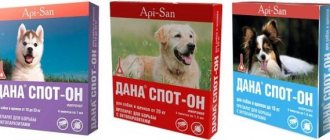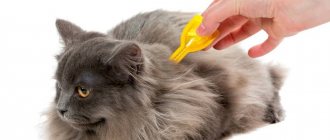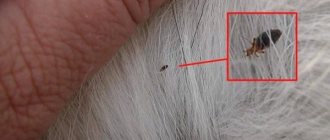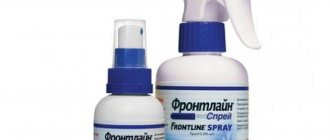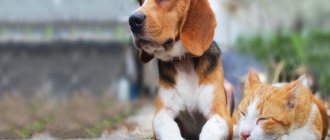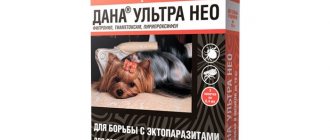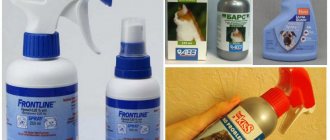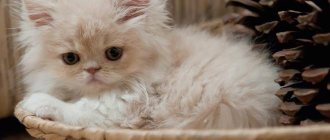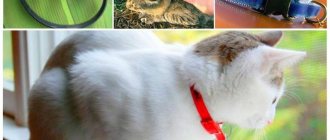Composition and release form
Studies were conducted with the participation of professors of veterinary medicine and veterinary dermatologists, in which the effectiveness of the drug was proven even with severe degrees of demodicosis and sarcoptic mange in combination with additional agents. “Dana Spot-On” is used in veterinary medicine to eliminate ectoparasites in pets. Irsectoacaricidal drops for cats contain the main component - fipronil. The solution also contains additional elements:
- lemon acid;
- polyethylene glycol;
- isopropyl alcohol;
- dimethylformamide.
The drug is produced in tubes with a concentration of 0.5 to 1.5 milliliters. The volume is chosen based on the individual characteristics of the pet. Pipettes are packaged in quantities of 3 or 4 ampoules. Larger bottles are sold individually. The box must contain instructions for use.
Properties
Dana Spot-on belongs to the insectoacaricidal drugs of the phenylpyrosol group. Fipronil, which is part of the drug, has a pronounced insectoacaricidal activity against the preimaginal and imaginal phases of development of fleas (Stenocephalides canis, Stenocephalides felis), lice (Linognatus setotus), lice lice (Trichodectes canis), sarcoptes (Sarcoptes canis, Sarcoptes vulpis, Notoedres cati, Otodectes cynotis, Psoroptes cuniculi), ixodes (Ixodes ricinus, Rhipicephalus sanguineus, Dermacentor reticulatus, Ixodes scapularis, Dermacentor variabilis) and demodectic ticks (Demodex canis). The mechanism of action of fipronil is to block GABA-dependent arthropod receptors, disrupting the transmission of nerve impulses, which leads to paralysis and death of insects and ticks. After applying the drug to the skin, fipronil, practically without being absorbed into the systemic bloodstream, spreads throughout the animal’s skin and hair, accumulates in the epidermis, hair follicles and sebaceous glands, providing a contact insectoacaricidal effect, which manifests itself after 12 - 24 hours and continues for 4 - 6 weeks after a single treatment of the animal. In terms of the degree of impact on the body, Dana Spot-on is classified as a low-hazard substance (hazard class 4 according to GOST 12.1.007-76), in recommended doses it does not have a skin-irritating, skin-resorptive or sensitizing effect, and if it gets into the eyes it causes mild irritation. fight. The drug is toxic to rabbits, bees, as well as fish and other aquatic organisms.
Indications and restrictions
The drug is effective for otodecosis in animals.
Veterinarians recommend an insectoacaricidal drug for animals from 3 months of age when infection is confirmed or to prevent diseases such as:
- Acarosis caused by the following insects: fleas;
- lice eaters;
- lice.
- arthropods;
Analogs and price
You can purchase Dana Spot-On drops in veterinary clinics, pet stores, or order online:
- for cats over 3 kg - the price is 95 rubles;
- for cats up to 3 kg - for 70 rubles.
There are analogues of the drug:
- Fiprist Spot On drops for cats - 200 rubles;
- “Frontline drops on the withers” (France) - 420 rubles.
Prices are average and shown for comparison.
So, correct diagnosis and use of Dana Spot-On drops in accordance with the instructions will save your pets from such unpleasant problems as infection with ectoparasites. The main thing is to respond to alarming symptoms in a timely manner.
Instructions for use
Dana flea drops are selected based on breed and weight category. For kittens less than 3 kg, a 0.5 ml ampoule is needed. A pet with a lot of weight needs 1 milliliter of medicine. To do this, you need to apply the emulsion directly to the skin, spreading the fur, to the cervical area or the interscapular area. This eliminates the possibility of licking the emulsion. Instructions for use suggest different treatment methods. “Dana” for cats should be dripped onto an intact and dry area of skin, spreading the fur. In summer, reuse after 4 weeks. If you have to frequently bathe your cat with shampoo, you can use drops after 15 days. Additionally, animal rugs should be replaced or treated with an insecticide.
To get rid of otodecosis, up to three treatments of the animal's ears may be required.
To eliminate a tick, a drop is applied to it and the bite area. The insect should fall off after 0.5 hours. If the parasite is still attached to the animal's body, you should carefully and independently pull out the arthropod and neutralize it. In case of otodectosis, the ear canal should be cleaned by removing crusts and scabs. Place up to 5 drops of solution into your ears and massage the base of the shell. The treatment is repeated a week later. Sometimes a cat needs 3 doses. It is recommended to always treat both ears.
Sarcoptic mange, demodectic mange and notohedrosis are treated by applying a thin layer to cleaned affected areas. It is important to apply the medicine from the edges to the center of the area, and it is also necessary to spread 1 cm of healthy skin around the perimeter. Severe lesions are eliminated with complex therapy. To do this, you will need to use symptomatic and pathogenetic drugs. The animal requires up to 5 treatments with a week break. Extensive damage is treated by dividing the treatment into 2 times with a daily interval.
Dana ultra-spray
1 ml of spray contains 5 mg of fipronil and 0.5 mg of cyfluthrin. The mechanism of the insectoacaricidal action of the aerosol is the same as that of drops. A
The spray for cats is produced in a volume of 95 ml, for dogs - 100 cm3.
The cost of a 100 ml bottle in January 2022 was 239 rubles.
Fipronil is a representative of insectoacaricides of the phenylpyrosol group, and cyfluthrin is a pyrethroid group. The drug protects pets from fleas, ticks and dipterous insects and mosquitoes immediately after treatment. Protection against flying parasites lasts for 5 days, ticks for a month, and fleas for a month and a half. An aerosol can is indispensable when the owner takes his pet with him when going outdoors. This spray protects animals from infection with Dirofilaria, which are carried by mosquitoes, and Pyroplasmas, which enter the bloodstream with the bite of an ixodid tick.
When spraying, it is necessary to protect the pet's eyes and mouth from the insecticide. The solution becomes safe when it dries, so for 20-30 minutes you need to put on a muzzle, Elizabethan collar or tie the jaws with braid.
The following aerosol insecticides have a similar effect:
- Aerosol Bolfo;
- BlochNet;
- Delix;
- Frontline.
Side effects, contraindications, storage rules are the same as for Dan drops.
Adverse reactions
If your cat is allergic to the components of the drops, side effects may occur. Serious signs of an allergic reaction can be treated with desensitizing treatment. Deviations can also be caused by a significant excess of the dosage when using “Dana” drops against fleas for cats. Then you should wash off the product with shampoo. If an excessive amount is used, remove the excess with a swab. Among the most common violations are:
A side effect of the drug may be drooling in your pet.
- skin irritation;
- copious flow of saliva;
- refusal to eat;
- vomit;
- trembling in the muscles.
Indications for use
The presence of ectoparasites can be noticed by the cat's intense scratching. If you shake off the litter into a wet bath, you may notice blood stains—this is flea excrement dissolving on the wet surface.
Important! After treatment for infection with ectoparasites, it is necessary to conduct a course of anthelminthic treatment for the cat.
Localization of parasites is usually observed in the neck area, on the head and in the tail area, where the skin is thin and sensitive, rich in blood vessels, and it is more difficult for the animal to lick the fur and catch parasites. When scratched, crusted wounds appear at the sites of bites, the skin peels, and hair loss is possible. The presence of tangles and matted fur is especially dangerous - this is a place where lice accumulate and a source of damage to the skin.
Ectoparasites themselves are not as dangerous as the consequences that can result from prolonged and untreated infestation:
- often skin parasites are carriers of helminths;
- possible infectious diseases from tick bites (encephalitis, borreliosis, tularemia);
- infected pets may become weak and unable to eat or rest properly;
- Inflammatory processes on the skin and suppuration in areas of scratching are possible.
Infection occurs when walking on the street, contact with infected animals, or from bedding. Parasites can be brought into the house on clothes and shoes from the street or from basements. In this case, infection is also observed in domestic cats that do not go outside.
Precautionary measures
Veterinarians, based on research, recommend avoiding the use of Dana Spot if the animal has pathological processes or the body is weakened, as well as during upcoming surgical interventions. You should refrain from using the drug if the cat is pregnant or nursing cubs. It is not recommended for kittens less than 2.5-3 months of age.
Doctors recommend using rubber gloves when carrying out therapeutic or preventive measures using Dana Spot-On. While working, it is prohibited to eat, smoke or drink.
Storage conditions and shelf life
Pipettes should be stored undamaged, in a dry and dark place, at a temperature of +2...+25°C, away from food and feed. The storage location should be inaccessible to children, who may be interested in the almost toy-like appearance of the dropper tube.
Shelf life: 2 years from the date of issue. Do not use expired medication
Unused drug and empty droppers must be disposed of in compliance with environmental legislation and safety regulations.
How to store the drug?
The shelf life of the medicinal product in question is two years from the date of its manufacture. Once this period has passed, the product will become several times more toxic and less safe. Therefore, its use is strictly prohibited.
After the expiration date, it is prohibited to use the drug
Storage of drops is allowed:
- only in the same packaging in which they were sold;
- in places where there are no food products, cosmetics, feed;
- only in a dry place;
- where there is no direct sunlight;
- at temperatures ranging from -2°C to + 25°C.
Active substance and mechanism of action
In different forms of release of the drug, different active substances are used, while ensuring complete safety of the use of insectoacaricidal agents, taking into account the size of the pet. All components are not addictive to parasites and have a selective effect.
The following active ingredients are used:
- fipronil;
- cyfluthrin;
- thiamethoxam;
- pyriproxyfen;
- permethrin.
All of these components have a detrimental effect on parasites, initially causing blocking of nerve impulses and subsequently their death. Dana also contains auxiliary components, such as glycerin, citric acid, polyethylene glycol, purified water, isopropyl alcohol and others. They improve the distribution of active components throughout the coat and increase their effectiveness.
How to use Dana drops correctly, instructions
Dogs and cats over three months of age can be treated for fleas with this product. Unlike other insecticidal preparations, Dana drops can be used regularly and for prophylactic purposes. Anti-flea drops help destroy blood-sucking pests that have already settled and are actively reproducing in the pet’s fur.
Another indication for the use of the drug is the treatment of otodectosis. This disease in animals is caused by mites, settling in the ears. Therapeutic drops with fipronil are applied to pre-treated skin.
Before using the medicine, make sure that the animal's skin is normal. Do not use the product if there are injuries, ulcers, or pustules. To apply the product, cut off the tip of the pipette and distribute the product pointwise over the withers. Those places that the pet cannot reach with its tongue and lick off the pesticide are subject to treatment - along the tail and ridge along the entire withers.
Operating principle
Fipronil and diazinon are two chemically different substances, but they work in the same way. Both compounds, penetrating the body of a flea, tick or louse, interfere with the transmission of nerve impulses, causing severe spasms. Under the influence of Dana drops, fleas die in a matter of seconds.
These substances are safe for mammals, including humans, but if the recommended dosage is exceeded, the risk of developing a toxic reaction increases. Depending on the weight of the pet, tubes of different sizes are used - they contain the required dose of the drug.
Shampoo
The main active ingredient in the shampoo is permethrin. Dana shampoo has the following effects:
- destroys fleas, ticks and other insects;
- eliminates unpleasant odor;
- promotes wound healing;
- relieves the animal from itching and other unpleasant symptoms;
- improves the condition of the coat (after use, the coat acquires a healthy shine).
Bathing procedure
Use Dana shampoo for dogs as follows:
- First, moisturize the animal's skin.
- Apply shampoo, maintaining a dosage of 0.5-1 ml per 1 kg of weight.
- Lather the product and lightly rub into the epidermis.
- After 5 minutes, rinse thoroughly with warm water.
- Dry and comb the coat.
After bathing, you can additionally use drops or other dosage forms of Dan to ensure reliable protection of the animal from insects.
Recommendations for working with the drug
There is a list of rules that a person who owns a dog that needs to be cured of fleas or other ectoparasites must follow. First of all, it is necessary to carry out processing in elementary protective equipment, such as:
- latex gloves;
- mask for the face;
- unnecessary home clothes.
- Latex gloves are an adequate measure of protection against contact of the product with the skin.
- While applying the drug, do not eat, drink, smoke, etc.
- For the next 24 hours, the animal treated with the product is literally untouchable. You can’t touch him, even if the pet fawns on you - it’s better to endure it for a while. Otherwise, you will remove the medicine from the animal’s fur and reduce its effectiveness, and even poison yourself with this insecticide.
- If you have an allergic reaction to the components of the drug, avoid direct contact with it.
- If you accidentally dropped the drug onto the skin, mucous membranes of the eyes, mouth, etc., immediately wash the area with plenty of warm water, if possible with soap.
If you have an allergic reaction, go to your doctor and take the product label with you
- Used packaging (both boxes and dropper ampoules) is strictly prohibited from being used after the medicine has been removed from it. Dispose of the packaging so that no one else can be harmed.
Owner reviews
Svetlana, owner of a German shepherd and a cat:
“I’ve been using Dan for my animals for two years now. I treat the dog with drops, and I buy collars for the cat. All last summer the animals had no fleas or ticks. This year everything is fine too. I'm satisfied with the result."
Maria, owner of the Rhodesian Ridgeback:
“Usually I didn’t notice insects on the dog, so I didn’t use any special products. But when after the walk we counted 19 ticks, we went straight to the veterinary pharmacy. We were advised to use Dana spray. We managed to get rid of parasites after the first treatment. Now we use a spray for prevention.”
Olga, owner of the Japanese Chin:
“In the summer, our dog moves to the dacha with us. We didn’t want to poison the animal with toxic drugs, so we decided to use Dana shampoo. No fleas were noticed, but ticks were still attached, so I also had to buy an expensive collar. After bathing, the wool becomes soft and acquires a pleasant aroma.”
Advantages and disadvantages
The drug Dana against fleas for dogs and cats has a number of advantages compared to other products of similar action.
Among them:
- ease of use;
- availability;
- safety;
- wide spectrum of action
- fast efficiency;
- prolonged action;
- no pungent odor.
But this series of drugs also has disadvantages. These include the likelihood of an allergic reaction and inadmissibility of use for pets younger than 10-12 weeks.
The role of ectoparasites in the life of cats and dogs
Fleas are, first of all, ectoparasites. This term includes insects and arachnids that live temporarily or permanently on the surface of the skin, never penetrate the body and feed on their host - skin cells, blood, hair and other products. It is worth emphasizing right away that the exchange of fleas between a dog and a cat is impossible - the feline type of parasites live on the cat, and the canine type - on the dogs.
No matter how unusual it may sound for many readers, a flea and its owner - a dog or cat - have been living together since ancient times. Of course, from much earlier than these animals were domesticated by humans. The word “commonwealth” was not chosen by chance; fleas live and feed at the expense of their owner, but they also benefit him. This phenomenon is called synergy and was described in this article.
But, if having fleas is so useful, why expel them, and why does the pharmacological veterinary industry produce so many different drugs against parasites?
It's all about population size, that is, the total number of fleas on one individual dog or cat, and, in addition, the general health of the pet. The blood of healthy animals contains substances that have a toxic effect against ectoparasites. As a result, fleas are constantly depressed, do not feed as often, and their reproduction process also slows down. This allows the parasite population to be kept within limits that are beneficial for the animal.
As soon as the dog or cat’s body weakens, as a result of insufficient nutrition or care, the appearance of infectious and parasitic diseases, the amount of these flea-inhibiting substances in the blood decreases noticeably, the fleas seem to wake up and begin to lead a more active lifestyle, multiplying uncontrollably. By the way, approximately the same picture is observed in young and elderly animals. For the former, protection against fleas does not yet work sufficiently functionally, and for the latter, it is already close to decline.
Useful Links Find out more about the benefits of flea collars for dogs using this link.
In some cases, the flea population may increase spontaneously, without any apparent reason. An attentive owner will immediately notice the difference:
- The animal's coat loses its shine and becomes dull.
- Constant molting begins. The hairs of the coat are first shed singly, then in whole tassels.
- The animal is actively and constantly itching.
- At night, dogs may yelp and whine from multiple bites.
- Upon careful examination of the coat, you can see a large number of fleas scurrying between the hairs.
It is necessary to fight fleas only if their concentration exceeds permissible standards.
